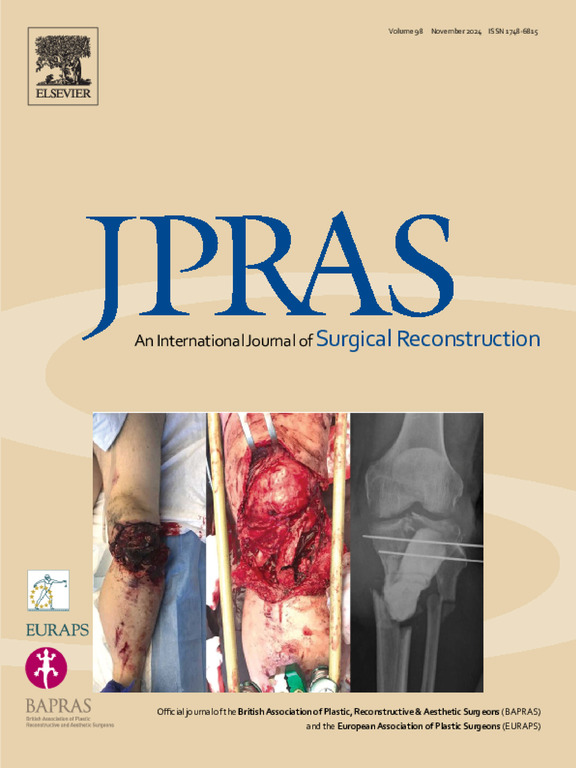重新定义假体乳房重建术中的感染管理:来自11年回顾性分析的见解和创新
IF 2
3区 医学
Q2 SURGERY
Journal of Plastic Reconstructive and Aesthetic Surgery
Pub Date : 2024-10-28
DOI:10.1016/j.bjps.2024.10.037
引用次数: 0
摘要
背景植入式乳房再造术相关的感染对患者和外科医生都是一个挑战,通常意味着高复发率、长期治疗(包括内科和外科治疗)、多次侵入性手术、延迟最终结果,在某些情况下甚至是重建失败。早期诊断至关重要,但并不总是容易实现。各种治疗方案可供选择,并已在文献中描述,没有明确的获胜策略。最近微生物学和治疗工具的改进使作者质疑什么是重建挽救方法的最佳计划。方法纳入2012 - 2023年间所有接受假体乳房重建术的患者。回顾性分析有关感染和治疗的临床记录。结果506例患者中,26例(5.14%)发生种植体相关感染。讨论结果时,我们意识到以前的协议是过时的,需要改进。通过多学科方法,推导出一种新的防治算法。首先,通过鼻腔和直肠拭子进行微生物筛查,可以在干预之前进行适当的去污。然而,关键的改进在于分子生物学分析的使用,从而最大限度地缩短了诊断时间,并允许在移除感染植入物后不久进行靶向抗生素治疗。此外,灌注负压创面治疗作为一种临时间隔物,对假体周围囊袋的维持起着重要的作用。结论在种植体相关感染的情况下,通过遵循这些精确的步骤,可以优化治疗,减少治疗和住院时间,使患者在相对较短的时间内实现重建。证据水平本文章由计算机程序翻译,如有差异,请以英文原文为准。
Redefining infection management in implant-based breast reconstruction: Insights and innovations from an 11-year retrospective analysis
Background
Infections associated with implant-based breast reconstructive surgery are challenging for both patients and surgeons, often implying high recurrence rate, long treatments (both medical and surgical management), multiple invasive procedures, and delay of the end-result and, in some cases, even reconstruction failure. Early diagnosis is crucial but not always easy to achieve. Various treatment options are available and have been described in literature, with no clear winning strategy. Recent improvements in microbiological and therapeutic tools have led the authors to question what would be considered the best plan for reconstruction salvage approach.
Methods
All patients who underwent implant-based breast reconstruction between 2012 and 2023 were enrolled. Clinical records regarding infections and treatment were retrospectively analyzed.
Results
Among a total of 506 patients, 26 (5.14%) developed implant-associated infections. Discussing the results, we realized that previous protocol was old-fashioned and required improvements. Through a multidisciplinary approach, a new prevention and treatment algorithm was derived. First, microbiological screening through nasal and rectal swab allows for proper decontamination prior to intervention. However, the keystone improvement consists in the use of molecular biology analysis, thus minimizing diagnosis timing and allowing targeted antibiotic therapy shortly after the removal of the infected implant. In addition, a fundamental role is played using instillation negative pressure wound therapy as a temporary spacer to ensure the maintenance of the periprosthetic pocket.
Conclusions
By following these precise steps in case of implant-associated infection, treatment can be optimized to reduce both therapy and hospitalization time, allowing the patient to achieve a reconstruction in a relatively short period.
Level of evidence
IV
求助全文
通过发布文献求助,成功后即可免费获取论文全文。
去求助
来源期刊
CiteScore
3.10
自引率
11.10%
发文量
578
审稿时长
3.5 months
期刊介绍:
JPRAS An International Journal of Surgical Reconstruction is one of the world''s leading international journals, covering all the reconstructive and aesthetic aspects of plastic surgery.
The journal presents the latest surgical procedures with audit and outcome studies of new and established techniques in plastic surgery including: cleft lip and palate and other heads and neck surgery, hand surgery, lower limb trauma, burns, skin cancer, breast surgery and aesthetic surgery.

 求助内容:
求助内容: 应助结果提醒方式:
应助结果提醒方式:


